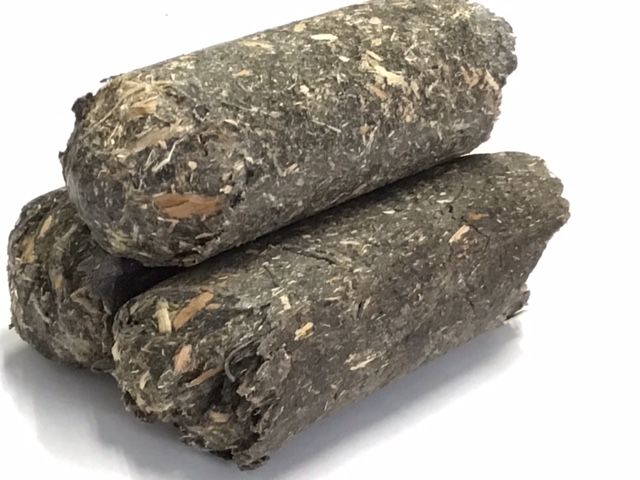What is "GREEN COAL" ?11111111 1=> Japanese

Plant-based biomass (derived from plants such as woody, herbaceous, and
paper), as main raw materials (about 90%), is made into GREEN COAL, a solid
fuel by a special manufacturing method, combined with waste plastics as
secondary raw materials (about 10%). It has a combustion heat comparable
to coal, and has been developed as a non-fossil solid fuel to replace coal.
The mixture rate is not limited to 90:10, and it is possible to increase
the waste plastic rate to more than 10% (increase the heating value). Conversely,
experiments have been successful in reducing the waste plastic rate to
5%.
Current Standard Type(classified as "Woody Biomass")
Primarily, 90% of wood (waste wood, wood debris, etc.) and 10% of waste
plastic are used as raw materials, intended to be classified as "woody
biomass" under FIT/FIP and J-Credit systems in Japan. Power generation
by Green Coal is admitted as a renewable energy (woody biomass power generation)
in FIT/FIP system, and also the project approval is to be registered with
the J-Credit system. Under Japanese FIT/FIP system, when the "woody
biomass" consists of waste wood, which is classified as constructed
waste, the price of power purchase for that category is currently \13/kWh.
However, \17/kWh is applied to "woody biomass" from pruned branches,
wood scraps and paper, and if raw materials from general wood is used as
"woody biomass", the price of power purchase for that category
is \24/kWh. (Provided, the biomass portion of 90% is covered.)
Types under Development
Pure Green Coal(provisional name): Instead of waste plastic, plant derived materials are used for binder function. In that case, it becomes a 100% pure plant-derived Green Coal. Although it is now almost successful on a trial basis, we are conducting further research and development to maintain the quality and calorie of Green Coal.
Super Green Coal(provisional name): Green Coal made from grasses such as Erianthus or Giant Miscanthus, which has particularly high greenhouse gas-absorbing capacity, in place of wood. They have CCSs (Carbon Capture & Storage) functions and higher carbon grounding capacity than wood, as well as higher burning calories, thus contributing to carbon-negative. Although Green Coal partially using these materials has been successful, research and development is underway to increase the ratio.
Ultra Green CoalorDream Green Coal(provisional name): By combining these techniques, the use of plant-derived materials in the binder part and grasses with high carbon underground storage capacity, we will accomplish our dream of creating carbon-negative Green Coal.
Benefits of GREEN COAL power generation
Part I - As a fuel for renewable energy (biomass power generation)
Green Coal is effective not only in terms of decarbonization by renewable
energy, but also in the realization of a community-cycling energy society
and in community resilience, including disaster prevention.
(1) Realization of carbon neutral & renewable energy policy for decarbonizing
society
(2) Coal-Fired Thermal Power Plants can be transformed and re-utilized
as a Re-Energy Power Plant (Biomass Power Plant) without requiring almost
any additional modifications to existing coal-fired thermal power plant
facilities.
(3) Contribute to waste plastic treatment
(4) By utilizing energy locally and installing biomass-fired thermal power
stations for local power supply fueled by self-sufficient Green Coal, local
production and local consumption of energy can be realized together with
the installation of Green Coal manufacturing facilities that use biomass
(waste materials, grass, waste paper, etc.) with local waste plastics.
In addition, by introducing a cogeneration system, thermal energy can also
be supplied to the region of the power plant using heat pipes.
(5) Achievement of Circular Economics
(6) Countermeasures for blackouts and other measures to strengthen resilience
in disaster prevention areas
(7) Measures against depopulated and isolated areas and islands
(8) Employment creation and regional revitalization
(9) Contributing to energy economic security by improving energy self-sufficiency
of Japan
Part 2 - Advantages over other woody biomass
(1) Substitutes for coal at thermal power stations with a high burning
calorie.
Since 2020, co-firing with coal has not been allowed at new biomass power
stations subject to FIT. Therefore, it is necessary to generate by only
biomass fuels, and there are few suitable biomass fuels for caloric increase
applications substituted for coals. Therefor a high calorie Green Coal
that is fit to be used in conjunction with conventional woody biomass is
one of the best solutions.
(2) Low-cost and easy procurement of raw material (raw materials are lying
at almost free of charge and in large quantities around)
(3) High and stable quality containing no harmful substances, uniformity
of quality meeting voluntary standards, compliance with standards by thorough
inspection and quality control, and proper and accurate labeling
(4) Stable supply (adequate production and supply to meet demands)
(5) Compared to other biomasses:easier to store and stock
As Green Coal has fixed properties, free of decay and deterioration, it
can be stocked for longer period of time. In addition, because it is rich
in water repellency, it is strong in rain water. On the other hand, because
the firing point is high, it is not dangerous to fire even under the flame.
Therefor, it is possible to store it outdoors, regardless of the storage
location. It is also ideal as a long-term storage reserve fuel for disaster
prevention including power outages.
111*We, Reserch Institute of Global Environment & Economy,aresupporting the spread of GREEN COAL technology.
Inquiry: greencoal.biomass@gmail.com